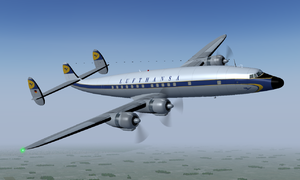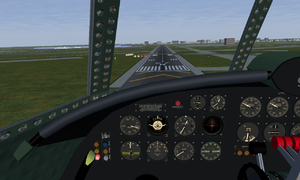Lockheed Constellation
This includes the following models: Lockheed 1049H Super Constellation
 | |
|---|---|
 | |
 The cockpit | |
| Type | Airliner, Cargo aircraft, Historical aircraft |
| Configuration | Twin boom aircraft |
| Propulsion | Propeller aircraft, Four-engine aircraft |
| Manufacturer | Lockheed |
| Author(s) |
|
| FDM | JSBSim |
| --aircraft= |
Lockheed1049h L1049h-engineer |
| Status | Early production |
| FDM |
|
| Systems |
|
| Cockpit |
|
| Model |
|
| Supports |
|
| Development | |
| Website |
|
| Repository |
|
| Download |
|
| Liveries |
|
| Forum |
|
| License | GPLv2+ |
|
| |
The Lockheed Constellation, affectionately known as the “Connie”, was a four-engine propeller-driven airliner built by between 1943 and 1958 at its Burbank, California, USA, facility. A total of 856 aircraft were produced in four models, all distinguished by a distinctive triple-tail design and graceful, dolphin-shaped fuselage. It was used as both a civilian airliner and U.S. military air transport plane, seeing service in the Berlin Airlift and as the presidential aircraft for U.S. President Dwight D. Eisenhower.
The Lockheed L-1049 Super Constellation was a member of the Lockheed Constellation aircraft line, and was Lockheed's response to the successful Douglas DC-6 airliner, first flying in 1950. The L-1049H variant flew on November 20, 1956. Called "Super H" and "Husky", the L-1049H was a convertible passenger/freight aircraft, mating a C-121C-based fuselage with L-1049G components. The cargo hold had a volume of 565 ft³ (16 m³) when including the lower hold. The aircraft could carry up to 120 people with seats, luggage lockers and toilets all available along with the option of decorating the walls of the aircraft. When not in use, the luggage lockers and seats could be stowed in the lower hold.
The aircraft entered service with QANTAS a month later. Some L-1049G and H aircraft in later production were fitted with the TC-18EA series engines used on the L-1649 Starliner. A final variant was planned in 1957, known as the L-1049J. Powered by four R-3350-988-TC-18EA-6 engines, the L-1049J was based on the L-1049H with the wings of the R7V-2 Constellation and an extra fuselage-mounted fuel tank.
Improved version can be downloaded from https://github.com/puku-777/Lockheed1049h
Compatibility
FlightGear 2.x: Loads and runs
FlightGear 3.0: Loads and runs
FlightGear 2016.4:Loads and runs
External links
Current features
As of version 3.0 (May 2017), advanced features of the Lockheed1049h include:
- Livery support.
- Realistic and tuned FDM.
- Realistic and tuned, 1956-vintage autopilot (but the generic autopilot dialog also works, for beginners).
- Realistic and complex fuel system with several presets, from no fuel management for beginners to full manual fuel management.
- Detailed checklists.
- Engine fire.
- Engine fire extinguishing.
- Fuel jettison.
- Realistic Fuel and Payload system.
- Dynamic load factor and speed limits (they depend on flight conditions).
- Windshield wipers.
- Autostart via the checklists.
- Dual control with a pilot and a flight engineer, using an all-new multiplayer protocol (not compatible with earlier versions of the Lockheed1049h).
Future (planned) features
- Realistic electrical system to power lights, engine starter, instruments, autopilot, auxiliary fuel pumps.
- Realistic hydraulic system to power control surfaces, main fuel pumps, brakes.
- Pressurization?
- Radar?
| ||||||||

